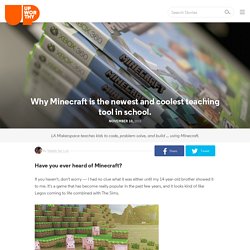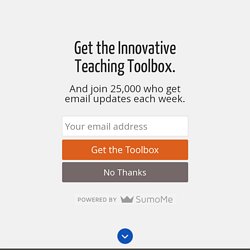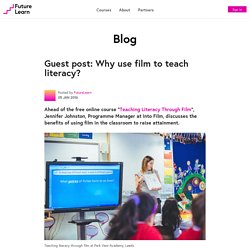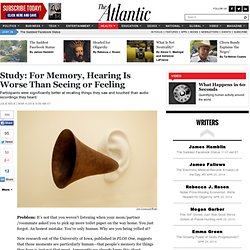

What Does a VU Meter Do and Why It Is Essential For a Great Mix. In the modern times of digital music, we have many sophisticated metering options available to us.

Sometimes these modern meters can be a bit “too much” in visual and numerical information. The solution: let’s go back in time and look at the VU meter. Must-have author insights for the summer months. As the academic year draws to a close, thoughts inevitably turn to getting on top of planning for next year.

In addition to taking a well-deserved break, teachers on TES still download over 60 million resources in the summer months! To help you make the most of this rush of activity on the site, we’ve created a sellers’ overview of hot topics, key dates and popular search terms, based on site data and statistics, to make your resource planning as easy and informed as possible. TESConnections.
Why Minecraft is the newest and coolest teaching tool in school. Have you ever heard of Minecraft?

If you haven't, don't worry — I had no clue what it was either until my 14-year-old brother showed it to me. It's a game that has become really popular in the past few years, and it looks kind of like Legos coming to life combined with The Sims. GIF via Daily Motion. In the game, you can build worlds, craft shelters, create tools, and go on missions. It's kind of old school but in a refreshing way. Minecraft might seem like just a sweet video game. Remember when "educational games" involved watching your pixelated family and livestock perish repeatedly on the Oregon Trail? The Unlearning Cycle (why we learn and how it's changing) – A.J. JULIANI. This is the second in a 4-part series answering the question, “Does education really need to change?”

Also, you’ll see these little buttons throughout –> . Guest post: Why use film to teach literacy? Blog Posted by FutureLearn05 Jan 2016 Ahead of the free online course “Teaching Literacy Through Film”, Jennifer Johnston, Programme Manager at Into Film, discusses the benefits of using film in the classroom to raise attainment.

Teaching literacy through film at Park View Academy, Leeds In a world where the moving image is becoming increasingly important, educators are increasingly interested in using film as a serious learning tool. This is a medium that is accessible to all, regardless of ability, with the power to bring to life aspects of the curriculum that some students may consider dull; portray subjects from science to Shakespeare in a different light; boost young people’s literacy, creativity and critical skills; and inspire disengaged pupils.
The Teacher Curse No One Wants to Talk About. Knowledge is a curse.

Knowing things isn't bad itself, but it causes unhealthy assumptions -- such as forgetting how hard it was to learn those things in the first place. Why The Right-Brain, Left-Brain Myth Is So Wrong. There's nothing quite so delicious as clean, simple answers for messy, complex things—like, say, our how our brains work and how they relate to our personalities.

Loads of books will tell you about how the left side of your brain is cold, analytical, and logical while the right ride is effusive, creative, and unruly, an odd couple co-habitating in your cranium, with your personality and team dynamics following suit. But new research suggests that this line of thinking is a simplification; it's not that creative people have more activity on the right side of their brain and that analytical people are weighted to the left. It's more complex than that. As University of Illinois cognitive neuroscientist Kara D. Developing digital literacies. Digital literacies are those capabilities which fit an individual for living, learning and working in a digital society. Digital literacy looks beyond functional IT skills to describe a richer set of digital behaviours, practices and identities.
What it means to be digitally literate changes over time and across contexts, so digital literacies are essentially a set of academic and professional situated practices supported by diverse and changing technologies. This definition quoted above can be used as a starting point to explore what key digital literacies are in a particular context eg university, college, service, department, subject area or professional environment. Digital literacies encompasses a range of other capabilities represented here in a seven elements model: Digital literacy as a developmental process Defining digital literacy in your context Background About this resource Further resources.
Vittra Telefonplan (English subtitles) - Presented by Videobrigade. Study: For Memory, Hearing Is Worse Than Seeing or Feeling - Julie Beck. Participants were significantly better at recalling things they saw and touched than audio recordings they heard.

Jim Linwood/flickr Problem: It’s not that you weren’t listening when your mom/partner/roommate asked you to pick up more toilet paper on the way home. You just forgot. An honest mistake. You’re only human. New research out of the University of Iowa, published in PLOS One, suggests that those moments are particularly human—that people’s memory for things they hear is just not that great.